Sustainable Durable Roofing
Sustainable roof systems must be durable and able to withstand anticipated rooftop maintenance activities and environmental events. Managers can accomplish this goal by specifying a high-compression cover board over the thermal insulation.
Positive roof drainage also is an important attribute of a sustainable roof, regardless of membrane type. But drainage is more than just roof slope. It includes verification that drains, piping, gutters, downspouts, and scuppers are properly sized for the building and geographical location. Good drainage also includes adding overflow drains and scuppers when appropriate.
Most roof systems must withstand foot traffic from maintenance workers. Sustainable roofs are designed to accommodate the safe movement of people and materials without causing performance, longevity, or watertightness problems. Managers can accomplish this by specifying high-compression cover boards, thicker membrane, and traffic pads.
They can improve safety by installing permanent handrails at units close to exposed edges, fall-protection screens on skylights, crossover stairs over piping, ramps over expansion joints, stairs between roof levels, and guard rails around roof hatches.
Most roofing materials are moisture-sensitive. This issue becomes extremely important when installing these materials in high-humidity environments. When specifying sustainable roofs, designers should consider the precaution and procedures required to maintain the integrity of roofing materials. Without proper moisture management, the roof system might have reduced resistance to wind uplift and reduced longevity.
When selecting a sustainable roof, one paramount criterion would be the use of a roof system with proven, documented, long-term performance. This performance must be on the roof, as no laboratory testing in the world can duplicate nature's impact on a roof system. The last thing managers want is to have to replace a prematurely failed roof system because it did not provide long-term performance.
That said, no roof system will provide ultimate performance without proper maintenance. Achieving maximum longevity from any sustainable roof system must include timely response to leaks, periodic cleaning of drains and gutters, debris removal, inspections and repairs after major weather events and as required.
Quality installation also is a necessary component of a sustainable roof system. If not properly installed, even the best roof materials will not provide a sustainable, long-lasting solution. Such results generally include a quality control and assurance component.
Putting It All Together
How can managers adequately measure the sustainability of their roof systems? Most professional designers will consider these sustainability criteria when recommending the best roof assembly for a building. Compare this approach to a roof system that is selected because it is the product a firm manufactures, sells or the system a roofing crew can install with the largest profit margin.
Managers also can use a sustainability rating system called RoofPoint, developed by the Center for Environmental Innovation in Roofing (CEIR). RoofPoint allows users to quantify the various tenets of sustainability, allowing them to compare the sustainable aspects of different roof designs. For more information about RoofPoint and other CEIR activities and resources, visit
www.roofingcenter.org.
Managers involved in selecting and installing roofing systems must update their beliefs that the subject of roof sustainability involves only a highly reflective, white membrane. Real roof sustainability results from the interaction of several key roofing components to create a durable, long-lasting system.
Curtis L. Liscum, RRC and RRO, is senior consultant and partner with Benchmark Inc., a national roof-consulting firm based in Cedar Rapids, Iowa. He has been involved with the roofing industry since 1979 and provides roof-consulting services throughout North America.
Spotlight: CEIR
The mission of the Center for Environmental Innovation in Roofing (CEIR) is to promote the development and use of environmentally responsible, high performance roof systems and technologies. The center serves as a forum to draw together the entire roofing industry to the common cause of raising public awareness of the strategic value of our nation's roofs in reducing energy consumption, mitigating environmental impact and enhancing the quality of the builds in which we live and work.
The center is the leading information source on sustainable roofing and serves as a clearinghouse for information. Through a collaborative, transparent process, the center's research committee members and staff maintain a comprehensive information database suited to a broad array of constituents, including building owners, design professionals, policymakers and industry stakeholders.
CEIR also has developed RoofPoint, a roofing-specific version of green-building rating systems that promote an environmentally responsible built environment. Similar to its whole-building counterparts, RoofPoint elevate the professional practice of everyone involved in the roofing process to a higher level of accomplishment and recognition. To accomplish this mission, RoofPoint embraces several important functions.
First, RoofPoint is a guideline for the selection of environmentally innovative roofing systems that maximize energy efficiency and longevity while minimizing the environmental impact. RoofPoint also serves as a checklist to identify the ways roofing systems provide economic and environmental benefits. RoofPoint serves as an assessment system to compare roofing alternatives for a particular application. Finally, RoofPoint provides a platform for a comprehensive certification program to recognize environmentally responsible roofing practices.
For more information on RoofPoint and other CEIR resources, visit www.roofingcenter.org.
|
Related Topics:













